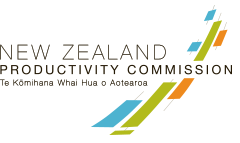Aotearoa New Zealand’s productivity performance overall remains low. The nation has increased its production of goods and services mainly by using more productive factors (working more hours and putting more people into work) and/or engaging in more harmful or depleting activities.
The relationship between productivity and wellbeing
For the Commission, as required by our Act, we need to consider the link between productivity and wellbeing. Productivity and wellbeing are interrelated, but in a complex and mutually beneficial way. For example, improved wellbeing has multiple influences, with productivity being just one of them. Wellbeing itself can also lead to higher productivity, as summarised in our publication, Productivity by the numbers.
Productivity gains that support rising material living standards are necessary pre-requisites for wellbeing improvements. We use Treasury’s Living Standards Framework and He Ara Waiora to consider wellbeing. These frameworks explore wellbeing from different cultural perspectives, values, and knowledge systems.
Our work centres on a core insight that productivity growth is about working smarter not harder. And then promoting understanding that such productivity growth is a pre-requisite for sustainable increases in incomes and material living standards.
Understanding the relationship between productivity and wellbeing allows us to approach our work in a way that makes productivity meaningful and not merely an end in itself. This enables us to focus on what’s beneficial for the people of Aotearoa New Zealand.
How can productivity be lifted?
Improving productivity requires a long-term commitment, with innovation and investment key factors to achieving this. The choices we make today will influence the productivity and standard of living tomorrow and for future generations.
There is no simple formula for lifting productivity.
The road to improvement sits with a wide range of actors. Successful economies are based on individuals, whānau, communities, businesses, iwi, and education and research institutions all doing the best with what they have, within the context set by the Government.
While choices made by the private sector determine the economy’s overall productivity performance, Government can encourage choices that raise productivity and wellbeing. Effective investment in people, physical capital, the natural environment, institutions and regulations, and innovation are all relevant to achieving a sustained shift in the productivity dial for Aotearoa New Zealand.
Innovation and technological change are critical to productivity growth. The Government can do that by building dynamic innovation ecosystems in specific areas of the economy, with firms at the centre of these ecosystems. But these ecosystems also include engaged workers with the right skills, international links, researchers, education and training providers, mentors and investors with deep knowledge and understanding of the industry and communities. Sustained long-term investments in these areas are central to lifting the productivity of the resources available to the nation.
The Māori economy exhibits many of the characteristics for long term investments that are needed for firms to innovate, grow, and support higher living standards.
Much of what the Commission explores is at the intersection of public and private sector interactions – the nature of the incentives faced by entrepreneurs as they make their choices and how those incentives can be designed to facilitate and encourage high productivity outcomes.
Among our previous inquiries, and as summarised in Productivity by the numbers, we have established findings and made a range of recommendations to help improve understanding of productivity and to inform and empower Government and change makers to support productivity growth.
